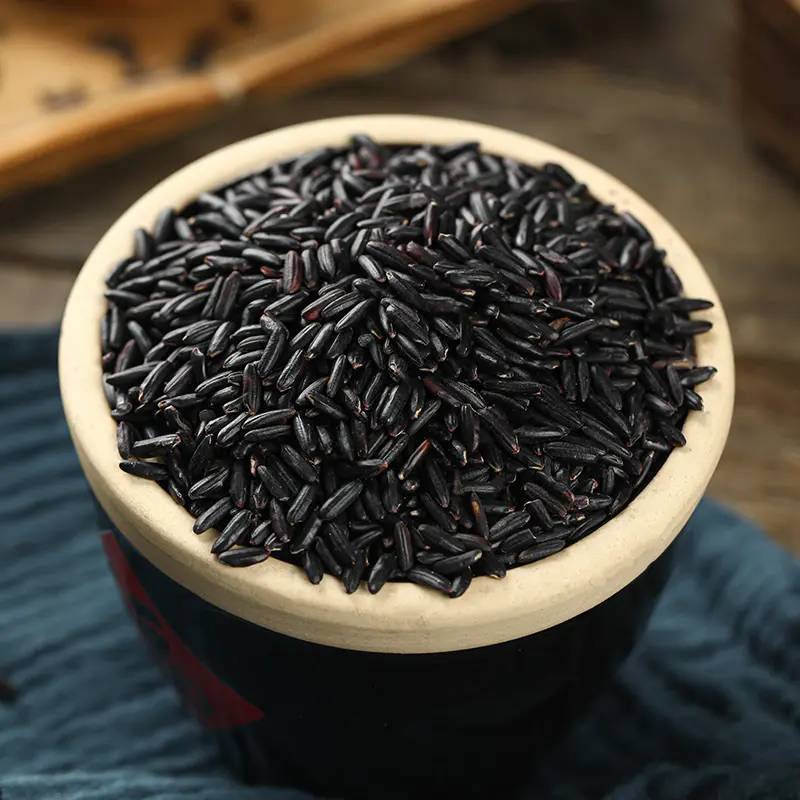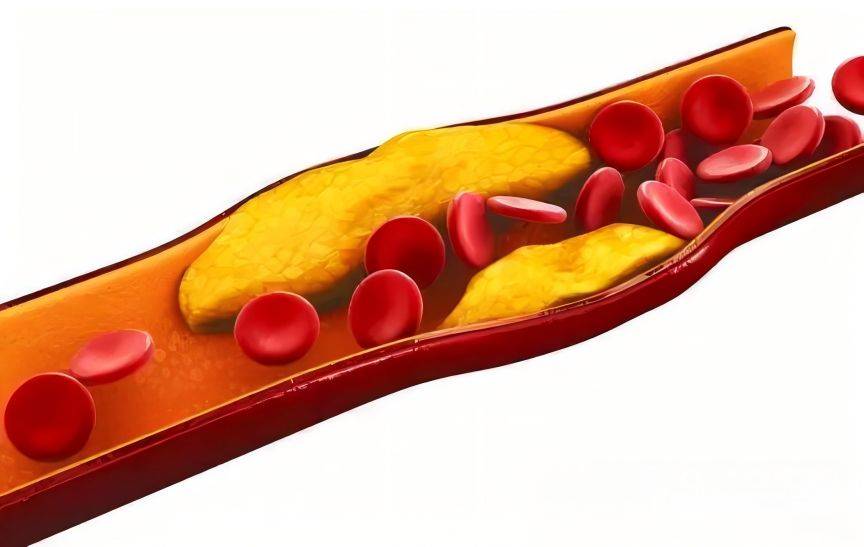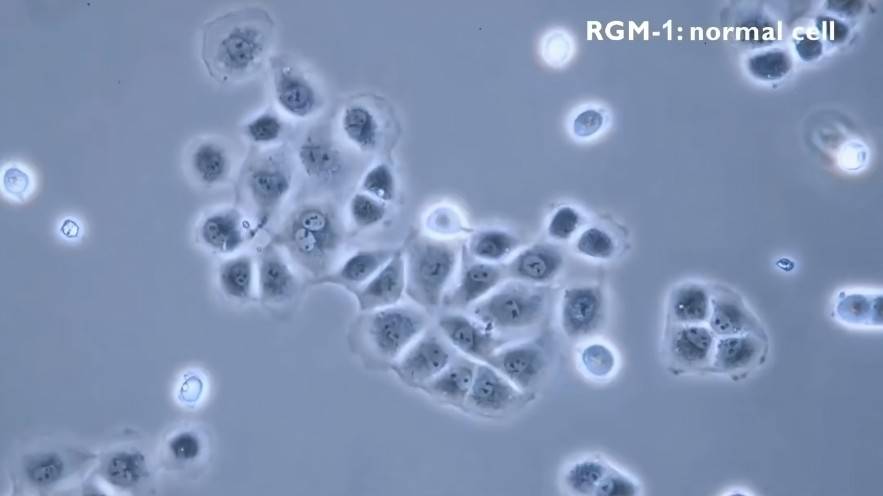Quel est l’avantage pour la santé de l’anthocyanine de riz noir?
Le riz est l’un des#39; S trois grandes cultures vivrières. Plus de la moitié du monde#39; la population utilise le riz comme aliment de base, et c’est l’une des cultures les plus importantes cultivées en Chine. Le riz est classé selon la couleur des grains. En plus du riz blanc commun, il y a aussi black rice, purple rice, red rice, green rice and yellow rice. The reason for the different colors of these colored rice grains is mainly that colored rice is rich in anthocyanin.
Pendant le développement du riz, l’anthocyanine se dépose dans le péricarpe, l’enveloppe des graines et la couche d’aleurone, et l’accumulation de pigments provoque l’apparition du riz brun dans différentes couleurs. Des études ont montré que plus la couleur du grain est foncée, plus il contient d’anthocyanes et plus ses propriétés antioxydantes et anti-âge sont fortes [1]. Le riz noir a la couleur de grain la plus sombre de tous les riz de couleur, de sorte que l’effet du pigment de riz noir est également le plus fort parmi tous les riz de couleur. Le riz noir est très nutritif et a un large éventail d’applications en termes de nourriture et de médicaments. Depuis l’antiquité, le riz noir jouit d’une réputation comme le "roi de tout le riz dans le monde", "perle noire", "riz sacré", "riz de médecine" et "riz de longévité", dans la culture populaire chinoise, il est dit que "le noir est toujours un remède". L’anthocyanine est un type de composé flavonoïde. En tant que substance active importante dans le riz, il donne non seulement au riz son excellente couleur, mais a également des fonctions physiologiques telles que l’anti-oxydation, la diminution des lipides sanguins, l’inhibition du cancer et de la lutte contre le cancer, l’inhibition des bactéries, anti-inflammatoires et anti-allergiques.

1 antioxydant
The most important active function of anthocyanin is its antioxidant capacity. Black rice anthocyanin can be used as a photoprotectant to eliminate free radicals produced during photosynthesis [2], enhance the antioxidant capacity of serum and liver, and significantly enhance the biological activity of glutathione peroxidase and superoxide dismutase [3]. Using the water-soluble antioxidant tocopherol as a control, the antioxidant activity of the anthocyanin extract from purple black rice is 10 to 25 times that of the same concentration of tocopherol [4]. The mechanism of anthocyanin antioxidant has been studied relatively thoroughly, mainly in the following ways: ①Anthocyanin contains multiple phenolic hydroxyl groups in its structure, which can inhibit or directly scavenge free radicals and prevent oxidative damage. 2. Anthocyanin can remove free radicals by activating the antioxidant enzyme system (including glutathione peroxidase, catalase and superoxide dismutase, etc.). In addition, anthocyanin can also chelate metal ions, cooperate with antioxidants to reduce or remove free radical damage to the body.
2 abaisser les lipides sanguins
Anthocyanin in black rice can effectively protect the kidney lipid peroxidation reaction in experimental mice [5], and can significantly inhibit the oxidative modification of human low-density lipoprotein. Yu Xiaoping et al. studied the effect of an anthocyanin extract from black rice husk on unstable plaques caused by atherosclerosis and found that the anthocyanin extract can significantly reduce the levels of low-density lipoprotein cholesterol, high-density lipoprotein cholesterol, cholesterol and triglyceride levels in the blood, and reduces the frequency of unstable plaque formation. Its effect is similar to that of the clinically used lipid-lowering drug simvastatin, significantly improving lipid metabolism and effectively reducing blood lipid levels [6].

3 inhibe la croissance des cellules tumorales
Black rice extract anthocyanins can significantly inhibit tumor cell proliferation and effectively induce apoptosis of tumor cells. The epidermal growth factor receptor (HER-2/neu) is a membrane receptor protein encoded by the proto-oncogene (ErbB-2). It is highly expressed in many types of malignant tumors, such as common colon cancer, ovarian cancer and breast cancer. Studies have shown that black rice anthocyanins can significantly inhibit the phosphorylation of HER-2/neu and extracellular regulated protein kinases (ERK-1/-2), and blocks the translocation of the transcription factor protein family member NF-κB p65 to the nucleus, thereby inhibiting the expression of genes such as vascular endothelial growth factor, matrix metalloproteinase, and urokinase plasminogen activator at the mRNA level, and blocking the HER-2/neu and downstream signal pathways (EGFR/Ras/MAPK), thereby inhibiting the expression of pro-angiogenic factors in tumor cells [7]. In addition, black rice anthocyanins can significantly inhibit the growth of HL-60 leukemia cells [8], the lung metastasis of breast cancer cell xenografts [9] and the proliferation of liver cancer cells [10]. They can also significantly inhibit the gene mutation of mammalian cells caused by tetranitroquinoline-1-oxide and inhibit the generation of tumor cells induced by phorbol [11].
4 effets antibactériens, anti-inflammatoires et anti-allergiques
L’anthocyane peut augmenter la perméabilité des membranes cellulaires, inhiber la division cellulaire et causer une croissance cellulaire anormale ou la mort cellulaire, présentant ainsi une activité antibactérienne [12]. Il peut effectivement inhiber la croissance de Staphylococcus aureus et d’escherichia coli [13]. Des études ont montré que la transcription et la traduction de l’oxyde nitrique synthase inducible (iNOS) et du facteur inflammatoire cyclooxygénase (COX-2) nécessitent la régulation du facteur de transcription nucléaire (NF-κB). L’anthocyane de l’enveloppe de riz noir peut inhiber significativement la fonction physiologique du facteur de transcription nucléaire (NF-κB) et réduire efficacement les plaques formées par l’athérosclérose, inhibant ainsi l’inflammation [14]. Les anthocyanines de riz noir peuvent réguler le déséquilibre entre l’interféron -γ et l’interleukine-4, réduisant ainsi efficacement l’infiltration de cellules inflammatoires dans les tissus du corps [15].
Anthocyanin in black rice significantly increases tyrosine phosphorylation of insulin receptor substrate-1 (IRS-1) by inhibiting the activation of aminopeptide endopeptidase in rat adipose tissue, thereby accelerating translocation of glucose transport. The overall content of oxidized glutathione and malondialdehyde, a lipid peroxide product, in the blood of rats fed anthocyanin was significantly lower, Anthocyanin supplementation in the diet can effectively improve the sensitivity of experimental mice to insulin, indicating an insulin-sensitizing effect of anthocyanins [16]. Anthocyanin extract can significantly inhibit the release of foot amine and the internal calcium uptake of cells, and significantly reduce the expression of interleukin 6 and tumor necrosis factor α protein, thereby significantly inhibiting the allergic reaction of experimental rats [17].

5 autres effets
Black rice Anthocyanin can effectively prevent cardiovascular disease, chronic disorders, degenerative diseases [18] and atherosclerosis [19]. It also has a significant protective effect on peroxidation damage to vascular endothelial cells caused by oxidized low-density lipoproteins [20], photochemical damage to the retina [21], and CCl4-induced subacute liver injury [22]. In addition, the alcoholic extract of black rice husk (anthocyanin) can inhibit tyrosinase activity, thereby inhibiting the synthesis of melanin and reducing skin pigmentation. Black rice anthocyanin can reduce skin pigmentation [23], lower the glycemic index, and prevent obesity and diabetes [24].
6 Conclusion
Ces dernières années, avec la dégradation de l’environnement et les changements dans les gens et#Dans les modes de vie, l’incidence des maladies chroniques modernes telles que l’hyperlipidémie, l’hyperglycémie, les maladies coronariennes et le cancer n’a cessé d’augmenter. Actuellement, environ 45% de la population en Chine est dans un état de sous-santé. Deux tiers de la population en Chine utilise le riz comme aliment de base, et la recherche et le développement de riz fonctionnel aura une grande importance pratique. L’anthocyanine est un composé flavonoïde. an important active substance in rice, not only gives it an excellent color, but also has physiological activities such as anti-oxidation, lowering blood lipids, antibacterial, anti-inflammatory and anti-cancer. Effective intake of Anthocyanin through eating black rice in the daily diet has become an effective means for people to achieve “food supplement” and “diet therapy”, and is playing an increasingly important role in the field of functional food development and research.
Références:
[1] Zhang Mingwei, Guo Baojiang, Chi Jianwei, et al. Effets antioxydants de différentes variétés de riz noir et leur relation avec la teneur totale en flavonoïdes et en anthocyanes [J]. Chinese Agricultural Science, 2005, 38 (7): 1324-1331.
[2] Hiemori M, Koh E, Mitchell AE. Influence de la cuisson sur les anthocyanines du riz noir (Oryza sativa L. japonica var. SBR) [J]. Journal of Agricultural and Food Chemistry, 2009, 57(5): 1908-1914.
[3] Zhang Mingwei, Zhang Ruifen, Guo Baojiang, et al. Effets antioxydants et hypolipidémiques de l’anthocyanine dans le son de riz noir [J]. Journal of Nutrition, 2006 (5): 404-408.
[4] Ichikawa H, Ichiyanagi T, Xu B, et al. Activité antioxydante de l’extrait d’anthocyane de riz violet noir [J]. Journal of Medicinal Food, 2001, 4(4): 211-218.
[5] Guo HH, Ling WH, Wang Q, et al. Effet de l’extrait de riz noir riche en anthocyanine (Oryza sativa L. indica) sur l’hyperlipidémie et la résistance à l’insuline chez les rats nourris au fructose [J]. Plant Foods for Human Nutrition, 2007, 62(1): 1-6.
[6] Yu Xiaoping, Xia Xiaodong, Min Xia, et al. Effets de l’anthocyanine de son de riz noir sur la stabilité des plaques athérosclérotiques [J]. Chinese Journal of Public Health, 2006, 22(2): 155-156.
[7] Yu Bin, Yu Xiaoping, Yi Long, et al. Mécanisme de l’anthocyane du riz noir inhibant l’expression de facteurs pro-angiogéniques dans les cellules cancéreuses du sein humaines [J]. Journal of Nutrition, 2010, 32(6): 545-550.
[8] Chang Hui, Mi Mantian, Ling Wenhua. Effets des anthocyanes de riz noir et des médicaments chimiothérapeutiques combinés sur la prolifération de différentes cellules tumorales [J]. Journal de la troisième université médicale militaire, 2007, 29(20): 1943-1946.
[9] Han Bin, Luo Liping, Chen Xiangyan, et al. Étude sur l’effet des anthocyanes de riz noir sur les métastases pulmonaires HER-2 positives pour le cancer du sein chez les souris nues [J]. Journal of Nutrition, 2014, 36 (3): 258-262.
[10] Chen PN, Kuo WH, Chiang CL, et al. Les anthocyanes de riz noir inhibent l’invasion des cellules cancéreuses par la répression des MMP et l’expression u-PA [J]. Chemico-Biological Interactions, 2006, 163(3): 218-229.
[11] Nam SH, Choi SP, Kang MY, et a1. Activités antioxydantes, antimutagènes et anticarcinogènes des extraits de son de riz dans des essais chimiques et cellulaires [J]. Journal of Agricultural and Food Chemistry, 2005, 53(3): 816-822.
[12] Deng GF, Xu XR, Zhang Y, et al. Composés phénoliques et bioactivités du riz pigmenté [J]. Critical Reviews in Food Science and Nutrition, 2013, 53(3): 296-306.
[13] Han YB, Zhu HM, Gu ZX et al. Étude sur l’effet antibactérien du pigment anthocyanique de la patate douce pourve [J]. Microbiology Bulletin, 2008, 35(6): 913-917.
[14] Zhang Yumei, Tang Zhihong, Min Xia, et al. Effet de l’anthocyanine sur la transduction du signal inflammatoire chez les souris déficientes en gène ApoE [J]. Journal of Nutrition, 2005, 27(3): 249-252, 255.
[15] Li Liangchang, Qin Xiangzheng, Li Guangzhao, et al. Effets de l’extrait d’anthocyanine de riz noir sur la voie de signalisation de la protéine kinase activée par mitogène p38 dans un modèle d’asthme de souris [J]. Anatoical Journal, 2012, 43(1): 38-41.
[16] Guo Honghui, Hu Yan, Liu Chi, et autres. Effets de l’anthocyanine du riz sur la sensibilité à l’insuline chez les rats nourris de fructose [J]. Chinese Journal of Public Health, 2008, 24(10): 1200-1202.
[17] Li Liangchang, Yan Guanghai, Qin Xiangzheng et al. Effets anti-allergiques de l’extrait d’anthocyanine de riz noir chez le rat [J]. Chinese Journal of Public Health, 2011, 27(5): 613-615.
[18] Hou DX, Fujii M, Terahara N, et al. Mécanismes moléculaires derrière les effets chimiopréventifs des antho cyanidines [J]. Journal of Bio medicine and Biotechnology, 2004(5): 321-325.
[19] Xia XD, Ling WH, Ma J, et al. Un extrait de riz noir riche en anthocyanes améliore la stabilisation de la plaque athérosclérotique chez les souris déficientes en apolipoprotéine E [J]. The Journal of Nutrition, 2006, 136(8): 2220-2225
[20] Zhang MY, Zhang RF, Guo BJ, et al. L’effet protecteur de l’anthocyanine de riz noir sur les dommages par peroxydation dans les cellules endothéliales vasculaires [J]. Journal of Nutrition, 2006, 28 (3): 216-220.
[21] Chen Wei, Ling Wenhua, Lv Xiaofei, et al. L’effet protecteur des anthocyanes sur les dommages photochimiques aux rétines du rat [J]. Chinese Journal of Public Health, 2011, 27 (4): 464-465.
[22] Hou Fangli, Zhang Ruifen, Zhang Mingwei, et al. Effet protecteur et mécanisme de l’anthocyanine de riz noir sur les lésions hépatiques subaiguës induites par le tétrachlorure de carbone [J]. Journal of Nutrition, 2009, 31(3): 254-258, 262.
[23]Miyazawa M, Oshima T, Koshio K, et al. Inhibiteur de la Tyrosinase du son de riz noir [J]. Journal of Agricultural and Food Chemistry, 2003, 5l(24): 6953-6956.
[24] Sasaki R, Nishimura N, Hoshino H, et al. La cyanidine 3-glucoside améliore l’hyperglycémie et la sensibilité à l’insuline en raison de la régulation défavorable de l’expression de la protéine 4 de liaison au rétinol chez les souris diabétiques [J]. Biochemical Pharmacology, 2007, 74 (11): 1619-1627.
-
Précédent précédent
Qu’est-ce que l’anthocyanine d’extrait de riz noir?
-
Suivant:
Qu’est-ce que l’anthocyanine de riz noir?


 Anglais
Anglais français
français espagnol
espagnol russe
russe coréen
coréen japonais
japonais



